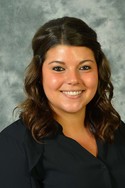Cancer Screening: The First Step Toward Early Treatment
by Allie Trudel
December 2019
Cancer is a disease that impacts everyone. If one has not personally battled cancer, it doesn't take long to recall a loved one or friend who has. Cancer is the second most common cause of death in North Dakota, causing 1,280 deaths in the state in 2017 alone.
Although cancer is overwhelming and scary, there are ways that certain types of cancers can be caught sooner, making earlier treatment possible. The United States Preventive Services Task Force (USPSTF) gives recommendations for cancer screening practices and has guidelines for early detection of breast, lung, colon and cervical cancer.
Breast cancer is the most common cancer in women in the United States. One in eight women will develop breast cancer by age 75. The screening technique used to look for breast cancer is called mammography, which is an x-ray image of the breast tissue. The current USPSTF guidelines suggest getting a mammogram every 2 years starting at the age of 50 and ending at age 74. Another group of physicians, the American College of Obstetricians and Gynecologists (ACOG), has different guidelines. They recommend getting the first mammogram at age 40, followed by one each year, or every other year, until a woman reaches the age 75. This guideline difference means it is important for women to talk with their doctor about the right screening intervals for their personal situation.
Though lung cancer is the second most common cancer behind breast cancer in women and prostate cancer in men, it actually causes the highest number of cancer deaths in the United States. The American Cancer Society estimates that in 2019, 300 North Dakotans will die from lung cancer and 430 new cases of lung cancer will be detected. Smoking is the most important risk factor for the development of lung cancer. For that reason, the USPSTF recommends screening for current smokers age 55 to 80 who've smoked at least one pack a day for 30 years. The Task Force says even smokers who've quit in the past 15 years need screening. What is the screening test for these people? A chest CAT scan once per year to look for any signs of lung cancer.
Colorectal cancer is the third most common cancer – and is the third most common cause of death from cancer in the United States. This means that around 120 people in North Dakota are expected to die from colorectal cancer in 2019. The USPSTF currently recommends screening for colorectal cancer by using one of two methods: using a kit to collect feces at home to send to a lab to look for signs of cancer, or having a test where a doctor uses a camera to look at the inside of your rectum and colon called a colonoscopy. The send-in test must be done every single year starting at age 50 and repeated until the age of 75. Colonoscopies also start at age 50. If the first test is negative for any precancers or cancers, it only needs to be repeated every 10 years.
Cervical cancer is another cancer that can kill women if not found early. The USPSTF recommends that every woman from the age of 21 to 65 have a pap smear at least every three years to look for signs of this cancer type. Once a woman turns 30, another helpful test is available: the human papillomavirus, or HPV test. HPV is a virus that is linked to cervical cancer. If a woman tests negative for this virus, pap smears and HPV testing need only be repeated every five years.
Cancer is common and cancer is scary. By participating in cancer screening practices, people can have cancers detected earlier, and get access to treatment sooner. West River Health Services in Hettinger offers several cancer screening services and the providers are well versed in determining which patients require what types of screening. Do not be that loved one or family member that dies from a cancer that can be detected early.
This article also appeared in the December 27, 2019 issue of the Adams County Record.
About the Author
 Allie Trudel is a third year medical student at
the University of North Dakota School of Medicine &
Health Sciences. She was selected as the Hettinger
participant for the school's ROME program, or Rural
Opportunities in Medical Education. The program includes
teaching student doctors the importance of rural
newspapers. As a future rural healthcare leader, Trudel
has written this column to provide health information for
her ROME community. The information is not for diagnosis
or treatment and should not be used in place of previous
medical advice provided by a licensed practitioner.
Allie Trudel is a third year medical student at
the University of North Dakota School of Medicine &
Health Sciences. She was selected as the Hettinger
participant for the school's ROME program, or Rural
Opportunities in Medical Education. The program includes
teaching student doctors the importance of rural
newspapers. As a future rural healthcare leader, Trudel
has written this column to provide health information for
her ROME community. The information is not for diagnosis
or treatment and should not be used in place of previous
medical advice provided by a licensed practitioner.
